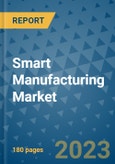The Global Smart Manufacturing Market has witnessed significant breakthroughs in recent times, driven by the increasing complexities in supply chains, rising importance of industrial automation, growing adoption of Industry 4.0 principles, and surging demand for advanced software systems. As a result, key industry players and governments worldwide are ramping up investments in research and development within the smart manufacturing market. Furthermore, the rapid adoption of sophisticated technologies and a rise in high-value mergers and acquisitions are expected to fuel the steady expansion of the global smart manufacturing market, promising lucrative outcomes for manufacturers and stakeholders across international markets.
With the relentless growth of Industry 4.0, the proliferation of novel technologies, and increasing investments in smart manufacturing solutions, the global smart manufacturing market is on a steady growth trajectory. The seamless integration of IoT-based applications and the rising popularity of digital twin technology are expected to unlock favorable economic opportunities for businesses. The Asia Pacific region, in particular, stands out as a favorable market with its dynamic SMEs and rapid adoption of advanced technologies. Market players like Siemens, Rockwell Automation, and IBM continue to lead the way in shaping the future of smart manufacturing.
Unlocking Economic Opportunities through Novel Technologies
Smart manufacturing organizations are rapidly embracing IoT-based applications, leading to the emergence of more sophisticated use cases that require advanced network capabilities. The advent of 5G is set to revolutionize IoT ecosystems, with a strong focus on improving connectivity parameters such as individual control, scalability, security, reliability, and latency of IoT devices. 5G's capabilities, including handling 1000x more consumption than existing networks, delivering multiple gigabits per second speed, and latency in single milliseconds, are expected to bolster the smart manufacturing market. Substantial investments in new network infrastructure and the adoption of 5G technologies are likely to drive growth in the industry.Digital Twin Technology Gains Momentum
Digital twins are poised to gain significant traction in the foreseeable future, driven by their efficacy in analysis and cost-saving benefits. This technology allows businesses to connect information about a physical product with its real-world behavior, presenting the data in a 3D digital representation. Enhanced visual analytics and insights associated with physical behaviors optimize operational efficiency and product output while minimizing costs. As a result, digital twins can significantly reduce the time and expenses involved in installing and validating production systems. The rising adoption of digital twins is projected to have a positive impact on the global smart manufacturing market during the forecast period.Asia Pacific Emerges as a Favored Region
The Asia Pacific region holds a major share in the smart manufacturing market and is expected to continue its growth momentum. This trend is primarily driven by the increasing adoption of smart manufacturing solutions among emerging SMEs and a thriving ecosystem in countries such as India, Australia, and Japan. Additionally, the widespread adoption of cutting-edge technologies such as AI, ML, IoT, and AR in the APAC region is set to propel further growth in its smart manufacturing market.Prominent Market Players
Leading players in the global smart manufacturing market include Siemens, Rockwell Automation, Honeywell International Inc., IBM, ABB, Schneider Electric, General Electric, and Emerson Electric Co. These companies are at the forefront of innovation, driving the adoption of smart manufacturing solutions across industries.With the relentless growth of Industry 4.0, the proliferation of novel technologies, and increasing investments in smart manufacturing solutions, the global smart manufacturing market is on a steady growth trajectory. The seamless integration of IoT-based applications and the rising popularity of digital twin technology are expected to unlock favorable economic opportunities for businesses. The Asia Pacific region, in particular, stands out as a favorable market with its dynamic SMEs and rapid adoption of advanced technologies. Market players like Siemens, Rockwell Automation, and IBM continue to lead the way in shaping the future of smart manufacturing.
Table of Contents
1. Executive Summary
2. Market Overview
3. Global Smart Manufacturing Market Outlook, 2018 - 2030
4. North America Smart Manufacturing Market Outlook, 2018 - 2030
5. Europe Smart Manufacturing Market Outlook, 2018 - 2030
6. Asia Pacific Smart Manufacturing Market Outlook, 2018 - 2030
7. Latin America Smart Manufacturing Market Outlook, 2018 - 2030
8. Middle East & Africa Smart Manufacturing Market Outlook, 2018 - 2030
9. Competitive Landscape
10. Appendix
Companies Mentioned (Partial List)
A selection of companies mentioned in this report includes, but is not limited to:
- Siemens AG
- ABB
- HP Development Company
- General Electric
- Honeywell International Inc.
- Mitsubishi Electric Corporation
- Schneider Electric
- IBM
- Rockwell Automation
- Schneider Electric
- Emerson Electric Co.
Methodology

LOADING...








